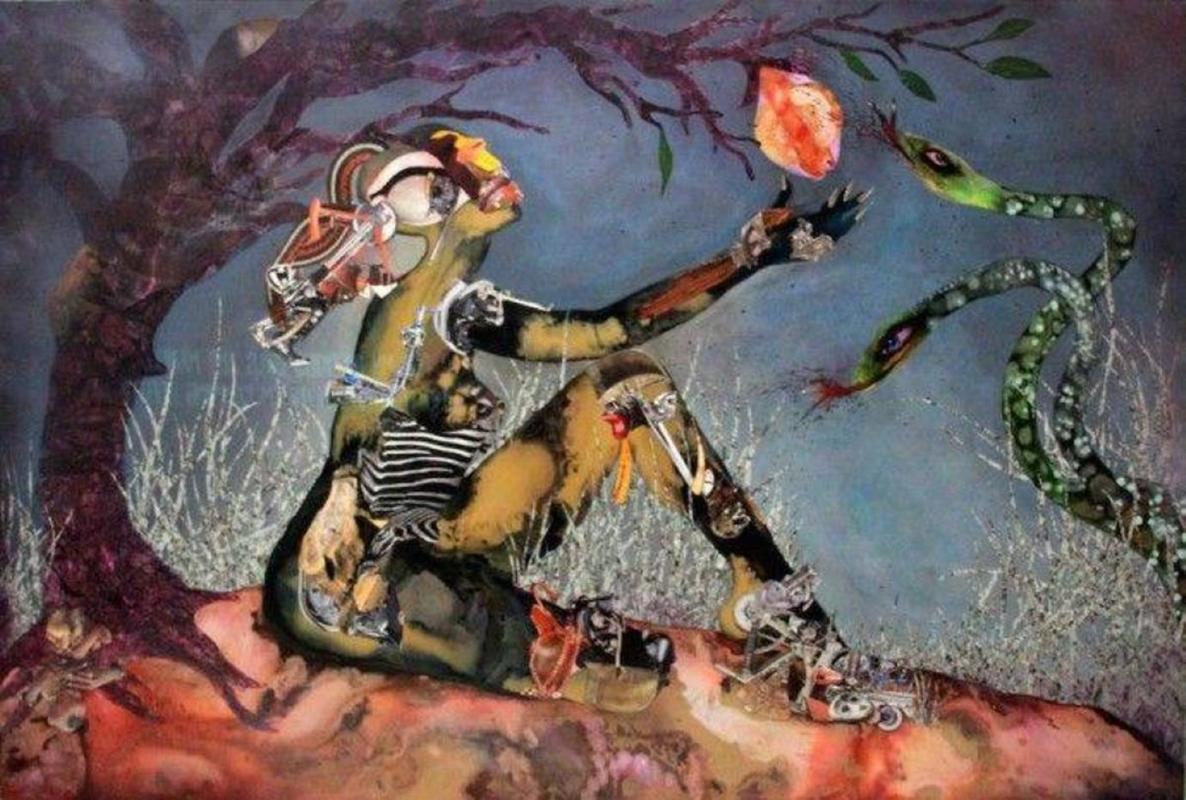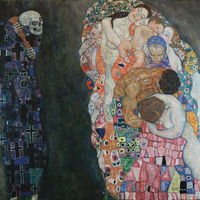More about Forbidden Fruit Picker

Art Instructor, Art School LLC
Though she may be best known for her sculptural installations, Kenyan-born artist Wangechi Mutu also makes provocative collages that reimagine the Black female body.
Mutu's complex compositions often merge bodily imagery and photo montage with motifs that comment on race, gender, colonialism, capitalism, and history. Early in her artistic career, Mutu “developed collage skills as a means of survival” because collage materials were more readily available than paints and other expensive art supplies.
The painting Forbidden Fruit Picker is exemplary of Mutu’s collage work - it is visceral, emotive, and a little haunting. It is a symbolically charged painting featuring a familiar cast of biblical characters that have been portrayed in art for centuries. The composition depicts a nude female figure, her internal mechanisms exposed, sitting beneath a gnarled tree. The figure reaches for a dangling piece of fruit while a two-headed snake flicks its bloodied tongue at her extended arm.
Like much of Mutu’s work, this composition marries paint and collage elements that include photo montage and fabric. The artist typically gathers her photographic imagery from magazines, advertisements, pornography, and medical textbooks. In this work, organic stains of paint are fused with cut fabrics and mechanical imagery onto a Mylar background. Mutu Frankensteins biological and technological imagery into a new whole, casting the female figure as a cyborg of sorts: part flesh, part machine. Forbidden Fruit Picker offers an alternative depiction of Black femininity that interrogates the misrepresentation and exoticization of the Black female body. It should also be noted that one of the figure’s legs is truncated at the knee–a reference to the history of immobilization and confinement experienced by women.
This sci-fi inspired approach to art making is Mutu’s articulation of Afrofuturism. Coined by Mark Derry in 1993, Afrofuturism is a multi-modal expression of the intersection of the African Diaspora and technology, explored through art, as well as literature, science, history, and culture. Writer Brendan Byrne describes Afrofuturism as "an aesthetic that uses the imaginative strategies of science fiction to envision alternate realities for Africa and people of African descent". In this vein, Mutu’s pastiche technique, suturing mechanical parts into the figure’s body, lends itself to themes of metamorphosis and hybridity, in addition to the objectification of Black women’s bodies.
As the title suggests, Forbidden Fruit Picker adopts a familiar strategy in art-making: biblical allegory. This work is Mutu’s personal spin on the well-known story about the Garden of Eden from the Book of Genesis. If you’re unfamiliar, here’s a quick re-cap: After creating Adam and Eve, God allows them to live in the Garden of Eden, where everything is provided for them and they are allowed to eat anything they wish, except for the fruit from the Tree of Knowledge of Good and Evil. Unfortunately, Eve encounters a snake that encourages her to eat the forbidden fruit. Unable to resist the temptation for knowledge, she succumbs to her desire to eat the fruit. She then “seduces” Adam into eating the fruit as well. As punishment, God banishes Adam and Eve from the Garden of Eden for their sins.
Does this story ring any bells? It might, even if you’re not familiar with the Bible, because depictions of Eve in art and pop culture are actually quite ubiquitous (think Snow White, Twilight, and even Britney Spears’s iconic snake performance). However, the narrative of Eve’s original sin has been damaging for women globally because, for centuries, it has been used as justification to defame and subjugate them. This story of Eve casts women as evil temptresses. Writer Julia Wolkoff observes that the narrative is “deeply rooted in the Western psyche […] women have spent millennia atoning for her original sin”. Though the figure in Mutu’s painting may be curbed by her amputated leg, she nearly dwarfs the tree and snakes in scale, positioning her as a figure of power and agency. She is both unafraid of danger and has a desire for knowledge. Most importantly, the woman is poised in the moment just before she picks the fruit. As such, Mutu opens up the possibility for revision of both the past and future for women.
Sources
- Byrne, Brendan. “Cyborg Humanism: Wangechi Mutu at Brooklyn Museum.” Rhizome, November 15, 2013. https://rhizome.org/editorial/2013/nov/15/cyborg-humanism-wangechi-mutu….
- Smith, Nicole. "Wangechi Mutu: Feminist Collage and the Cyborg”. Thesis, Georgia State University, 2009. https://scholarworks.gsu.edu/art_design_theses/51.
- Wolkoff, Julia. “Decoding Depictions of Eve in Art and Pop Culture.” CNN. Cable News Network, July 31, 2019. https://www.cnn.com/style/article/eve-art-pop-culture-artsy/index.html.












